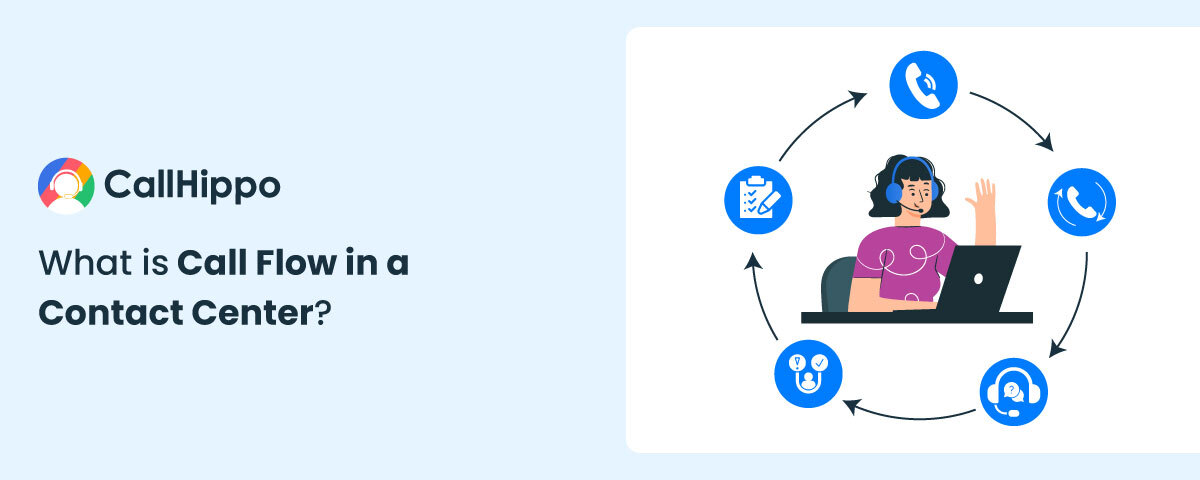Do You Want to Make More Calls?
Set up CallHippo VoIP system in less than 3 minutes and start calling.
Senior Writer: Supriya Bajaj
Modern businesses and their customers are far different than what they were a decade ago. Today’s businesses strive to excel in customer support to build strong, long-lasting relationships with their customers. But amidst the flurry of inbound calls, the undefined structure and flow of the conversations often leave customers frustrated. In fact, according to research, 39% of customers have less patience today than they did before the pandemic. A well-defined call flow for customer service can help businesses overcome this problem.
In this blog, we will go through the basics of call flow in call centers, exploring its importance, types, challenges, and more to help businesses master this crucial aspect of customer service.

Ensure a streamlined call flow for your call center to improve the customer experience and resolve issues faster. Invest in the right virtual phone system software to implement the right steps for seamless call flow to improve operations and agent efficiency.
What Is a Call Flow?
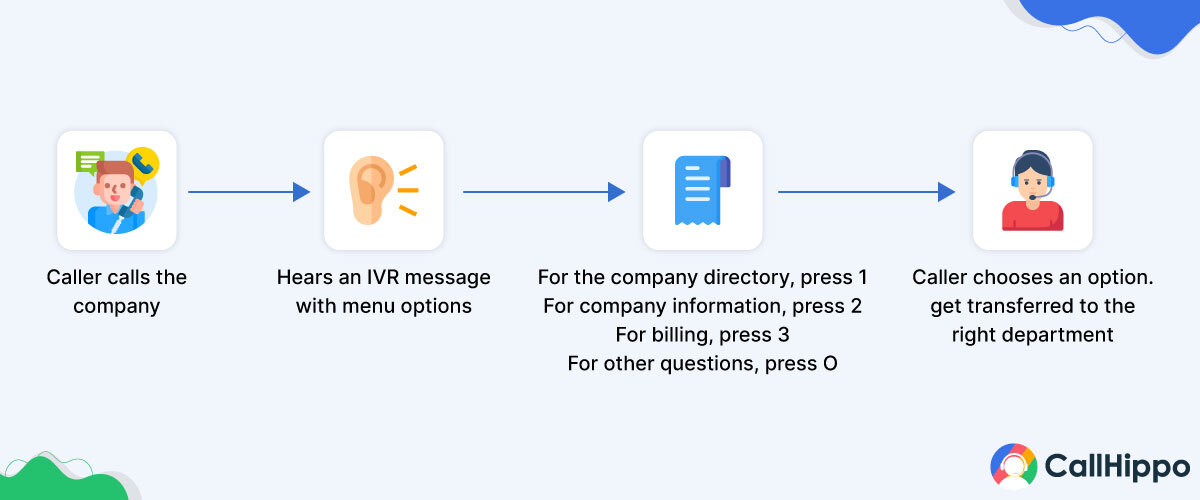
A call flow is a pathway through which your customers make their way into your call center when they dial in. It helps ensure a seamless journey for your customers from the beginning to the end of the call. A clearly defined call flow also helps your customers get connected to the right customer service agent or department as quickly as possible.
The perfect customer service call flow must include accurate instructions in the form of directions, messages, or self-service options to guide customers from the moment their call gets connected. It also includes the right steps for customer service agents to resolve problems after customers connect with them. These involve greetings, problem inquiry, resolution, and so on.
Call flow for call center can be simple or complex. For example, the simplest one is where the contact center representative directly greets the dialer, and the complex one involves an array of options provided by an IVR. In complex call flows, the dialer chooses a relevant option from the menu, such as connecting to an agent, knowing your account details, changing your password, etc.
Why is Call Flow Important for Call Centers?
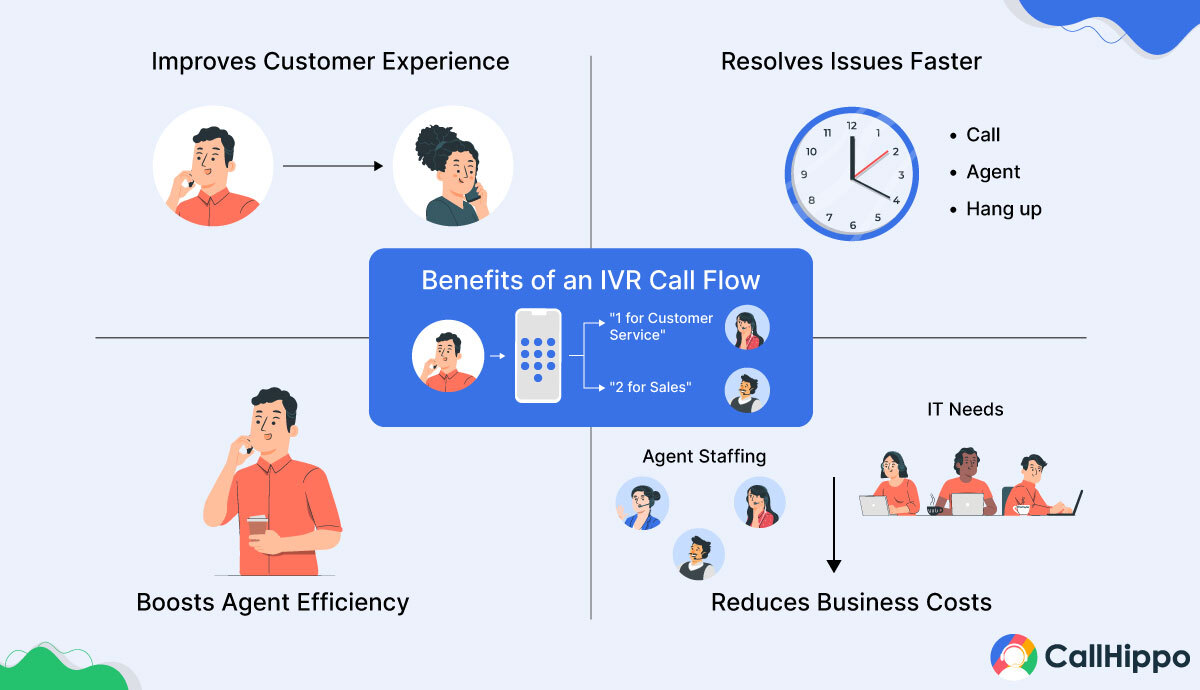
Call flow plays a major role in customer service success. Call flow empowers your customers to receive quick assistance without swinging between agents and departments. It saves your customers valuable time by sending them in the right direction. Since call flows assist agents in providing prompt resolution, they can help your call center make a great first impression about your services, boost customer satisfaction, and improve customer loyalty, which are pivotal in today’s competitive business landscape.
Call flows are equally important for your call center and its agents, as they have a direct impact on certain call center metrics. They give them step-by-step guidance to handle customer queries more efficiently. A proper call flow can reduce call hold time, average handling time, call length, repeat calls, etc., in your call center. Plus, advancements like IVR and automated routing in your call flow can further resolve major customer service problems like busy lines and redirected calls.
Overall, call flows enhance the operations of your call center through effective resource allocation, optimized workflows, and improved agent performance.
How Does a Call Flow Work?
Understanding the key steps involved in a call flow is important to improve your customer service experience. The number of steps involved in the process varies as per the specific needs of a call center. Let’s understand the seven essential steps that are involved in every call flow process.
Step-1. Call Center Receives a Call
The call flow is activated when someone calls the designated phone number. This number could be your local number, toll-free number, or virtual phone number. Once the phone call comes in, a preconfigured call flow begins, where the customer is greeted and offered a range of options to choose from. In the case of simple call flows, the customer is directly greeted by a receptionist and connected to the concerned person.
Step-2. IVR System is Activated
Most call centers these days are equipped with an IVR (Interactive Voice Response) system that enables the caller to interact with a computer-operated telephone system. The IVR menu provides options to choose from, such as dial 1 for inquiries, dial 2 for customer support, dial 3 for the main menu, and so on. The IVR helps customers navigate through the call center and saves the time of your agents by connecting them to the right person.
You May Also Read : Best IVR Service Providers : Buyers Guide
Step-3. Call is Routed to an Agent
When the caller presses a desired key through the provided IVR menu, a business phone system routes it to the relevant destination, which could be a specific person or department. The call routing system connects the caller with qualified, available agents and helps reduce wait times and improve customer experience. If an agent is not available, an additional call queuing step in the call flow directs the caller to a virtual line and places them on hold until the ideal contact center representative becomes available.
Step-4. Agent Interacts With the Customer
When the customer’s call is connected to a call center agent, the process of troubleshooting begins. At this point, a qualified representative asks probing questions to understand the customer’s issue or inquiry and gathers relevant information required for assistance. Then, the agent provides stepwise troubleshooting assistance to the customer or escalates the call for a higher level of support if required.
Step-5. Summarizing
After the issue has been resolved or the query has been addressed, the agent summarizes the conversation for the customer’s satisfaction. During this step, the agent provides a quick recap of the customer’s problem and the provided resolution and asks the customer if there is anything else they want to be assisted with. The agent may also schedule a follow-up call if instant resolution is not possible.
Step-6. Closure
Once the caller’s satisfaction with the resolution is confirmed, it is important to end the call with a simple gratitude message to leave a positive impression of the business. The call center may also ask the customer to help improve their services by providing customer support ratings or filling out a customer satisfaction survey form. Some call flows may also include a post-call survey to gather customer feedback.
Step-7. Post-assistance Activities
The documentation of summaries or notes in the phone system or CRM system is crucial for performance monitoring and call script optimization. These post-assistance activities help identify the pain points or bottlenecks in the call flow by making necessary changes in the call script so that it better aligns with the conversation happening at each stage of the call flow. This analysis also helps identify the areas of training for the agents.
5 Common Types of Call Flows in Call Center
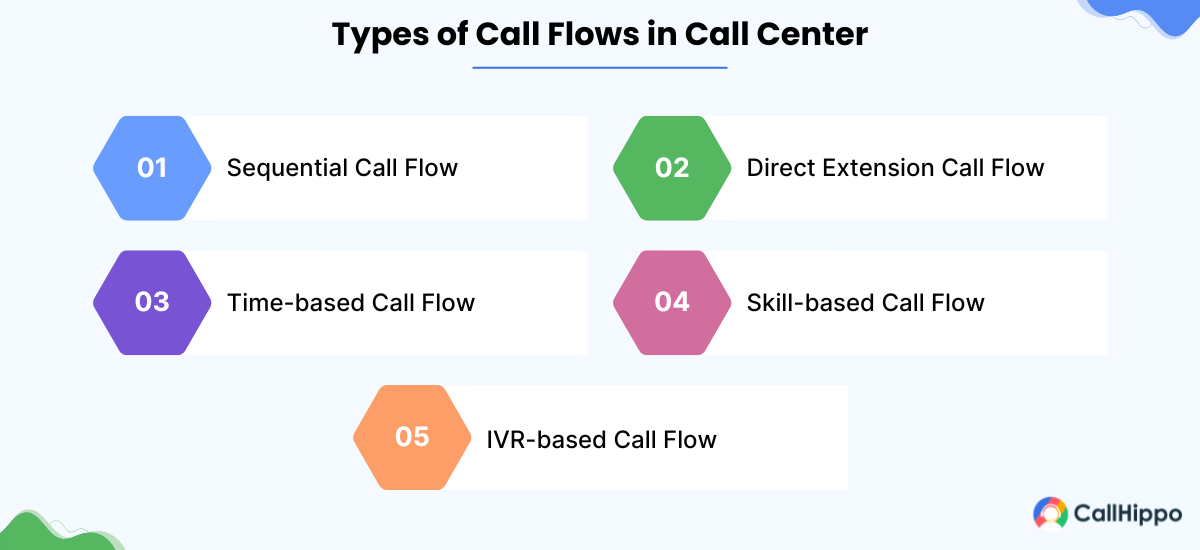
1. Sequential Call Flow
A sequential or linear customer service call flow is the most straightforward type of call flow in a call center. In this type of call flow, inbound calls are directly routed to an available agent. If an agent is not available, the call is transferred to a predetermined extension or voicemail. These types of call flows are ideal for small businesses and call centers with minimal call volumes.
Example: Consider calling a small manufacturing business, where incoming calls are sequentially routed to an agent or receptionist who can assist the caller with questions about sales, orders, packaging, dispatch status, etc.
2. Direct Extension Call Flow
This is the type of call flow in which the incoming call is directed straight to a designated extension or individual. The direct extension or direct dial call flow lacks any menu or options and enables the caller to quickly connect with the concerned person without any delays. This type of call flows are common in small or medium-sized businesses, especially where the dialer knows the extension of the person that they wish to connect to.
Example: In an office where the customers need to frequently connect with project managers or associates, callers generally know the extensions so that they can directly reach the desired person without having to listen to the automated menu.
3. Time-based Call Flow
A time-based call flow is a type of call flow that involves different call routing based on the time of the day, day of the week, or custom days or dates. Depending on the predetermined routing, the phone calls are transferred to different agents or offices. This type of call flow works better for businesses that wish to provide prompt customer support irrespective of the day, date, or time of contact.
Example: For a global e-commerce business that may receive calls from different parts of the country, the time-based call flows help customers connect with an available agent in one of the contact centers whose operational timings align with the caller.
4. Skill-based Call Flow
In skill-based call flows, calls are routed to agents or teams based on their skill set or expertise. To connect the caller with the most qualified agent, an IVR or contact center agent analyses the customer’s query and transfers the call automatically or manually based on that. Skill-based call flows ensure that your customers receive only top-level service from agents that can best handle their specific needs.
Example: In an information technology company, calls about software issues are typically sent to agents who specialize in software troubleshooting, whereas calls about sales inquires are routed to agents who specialize in sales and marketing with the help of skill-based call flow in call center.
5. IVR-based Call Flow
In an interactive voice response system-based call flow, incoming phone calls are automatically routed by the IVR based on the caller’s selection of specific keys or options. Similar to direct extension call flows, customers know what they are looking for here. An IVR-based call flow is also known as an auto-attendant call flow.
Example: A customer support hotline presents its customers with an interactive voice response menu to allow them to navigate and select a specific language, service category, or a specific issue by pressing a specific number key. Based on their selection, the call is transferred to a specialized agent for further assistance.
Things to Keep in Mind When Designing a Call Flow
While there are some specific points to consider when designing a successful call flow for your call center, it is necessary to acknowledge that every business is different. Your company’s requirements are unique, so your call flow process should streamline your workflow and help your agents deliver exceptional customer support. Here are 10 important points you must keep in mind before you begin:
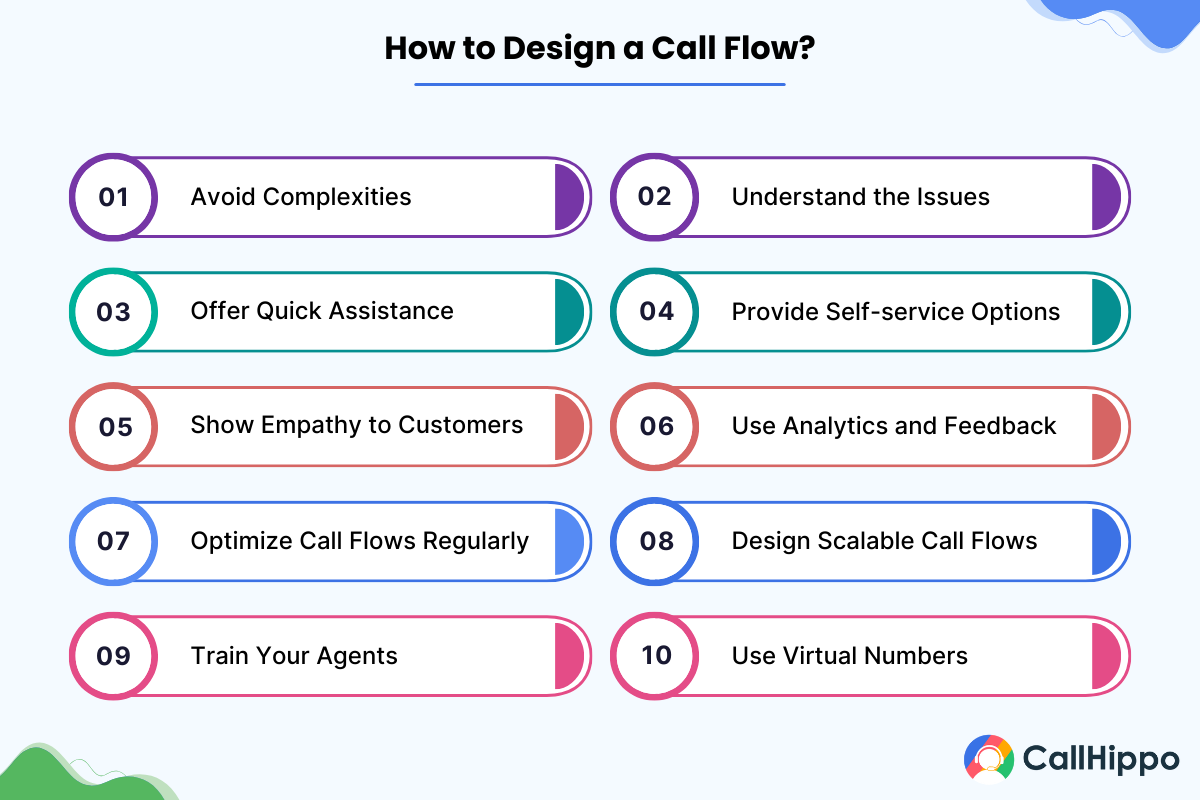
A. Avoid Complexities
When designing a call flow, it’s crucial to keep it all as simple and clear as possible. Always design call flows with customer-centricity and brevity so that your customers can get solutions to their problems quickly. Ensure that your IVR options are concise to avoid any overlaps or miscommunications.
B. Understand the Issues
Prioritize focusing on issue identification in the initial stages of the call flow to ensure effective call routing. By identifying and addressing the customer’s reason for calling, the call can be transmitted to the right person or agent, and the customer service team can provide quick assistance to the customer’s query.
C. Offer Quick Assistance
Offering quick assistance to customer queries can minimize wait times and enhance satisfaction, fostering a positive customer experience. This can be achieved by crafting scripts to read out for common concerns and drafting emails or messages that can help customers with the same so that agents only have to read or send them in order to provide instant support.
D. Provide Self-service Options
Implement IVR systems and online portals to empower customers to resolve simple inquiries independently, reducing agent workload and enhancing call center efficiency. An IVR with self-service options is a great way to answer queries based on the information that your system already has about your customer’s problem.
E. Show Empathy to Your Customers
When agents talk to customers, they must sound like they are genuinely interested and concerned about the customer’s query. They can do so by using comforting and empathetic messages that make the customer feel important and heard. Moreover, agents should reassure the customer that they will receive quick support and that you are working on their request.
You May Also Read : 30 Examples of Empathy Statements For Customer Service That Work
F. Use Analytics and Feedback
Utilize the collected data to acquire an understanding of how well your call center agents are working. The analytics and feedback of your call center will also help you identify trends, optimize contact center workflows, pinpoint areas for improvement, and refine call flow strategies for better performance.
G. Optimize Call Flows Regularly
Maintaining and boosting your customer satisfaction rate is equally vital as providing great customer service. You can manage your call flows by regularly updating and optimizing them to meet changing business needs. Make sure to update your IVR options anytime there are changes to business hours, departments, offerings, or the addition of new departments or services.
H. Design Scalable Call Flows
Call volumes in a call center can fluctuate according to market demands or seasons. Therefore, when designing a call flow process, keep in mind that your call flow is scalable to the point of maxing out your phone system without call drops during the busiest hours. Creating scalable call flows that are capable of varying call volumes will help accommodate business growth.
I. Train Your Agents
One of the most important ways to ensure good call flow in your company is to train your agents to modify it as and when needed. Customer interactions are unpredictable, and many different scenarios may arise where the agents have to modify the script and flow to align with the conversation. Therefore, providing comprehensive agent training will help ensure consistent customer service.
J. Use Virtual Numbers
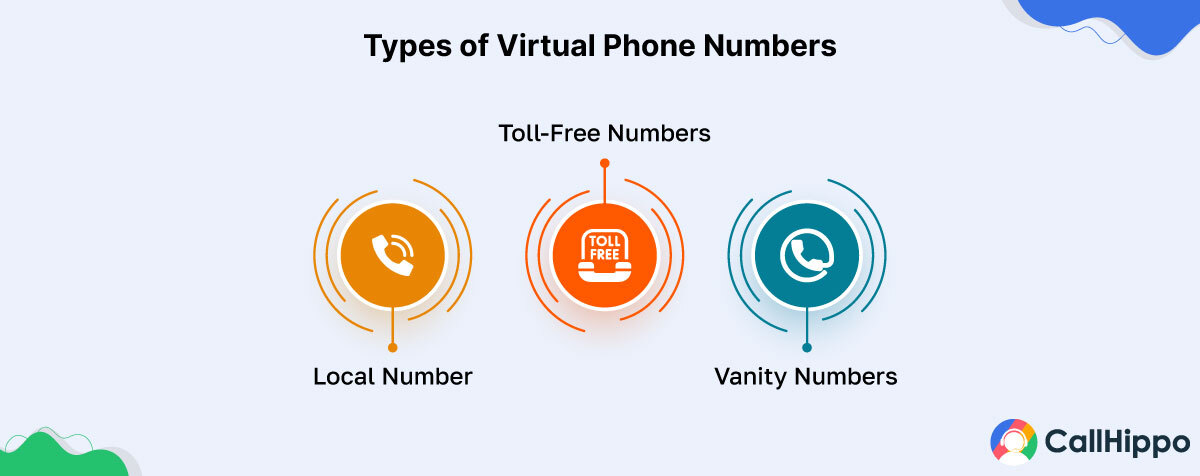
Using virtual business phone numbers can help you in efficient call routing. Phone numbers that are easy to memorize or are vanity numbers also improve the brand image of your company. Virtual phone numbers are especially beneficial for catering to VIP clients or handling urgent situations where immediate support is imperative due to extreme circumstances.
What are the Common Challenges in Call Flow?
Several challenges may come across designing, using, and optimizing the call flows for call center. Learning about these challenges and keeping them in mind when implementing call flows for call center might help you overcome them. Here are some of the common challenges in call flow:
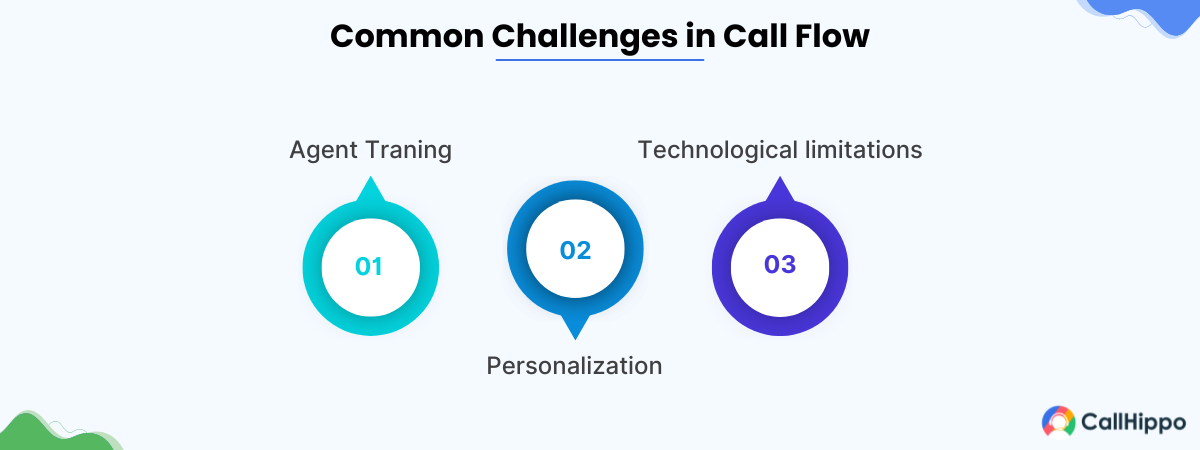
1. Agent Traning
Ensuring consistency and proficiency among agents may be challenging, especially in the call flows of large teams or complex call environments. Therefore, it is crucial to provide comprehensive, ongoing, and tailored training sessions to address specific call flow scenarios and customer needs.
2. Personalization
Although personalized call flows for call center can help deliver great customer experiences, maintaining consistency with them can be challenging. Challenges like outdated or incompatible systems, lack of automation capabilities, and constraints in customization may hinder the implementation of a seamless call flow process when using call center technology.
3. Technological limitations
Call center operations greatly rely on technology, which can again come with its own challenges. When using call center technology, challenges like outdated or incompatible systems, lack of automation capabilities, and constraints in customization may hinder the implementation of a seamless call flow.
Bottom Line
Having a well-defined call flow for customer service plays a major role in your contact centers’ success. A good call flow contributes to effective customer support management and helps your agents deliver top-notch customer support. Now that you know the importance, types, and challenges of call flow, take the right step by creating an effective call flow process in your business phone system.
FAQs
Is There Any Difference Between Call Flow Script and Calling Flow?
Call center scripts are responses or steps that help call center agents handle common customer issues quickly, whereas a call flow is a blueprint of how a successful conversation on call should flow.
What Tools Can Help Improve Call Center Call Flow?
You can improve call center call flow processes by incorporating tools like Interactive Voice Response, Call Management System, Automatic Call Distributor, etc.
How Can You Measure the Success of Call Flow Implementation?
The success of call flow implementation can be measured through various key performance indicators (KPIs), such as First Call Resolution (FCR), Average Handling Time (AHT), Customer Satisfaction Rate (CSAT), Call Abandonment Rate, and so on.

Subscribe to our newsletter & never miss our latest news and promotions.
 +21K people have already subscribed
+21K people have already subscribed